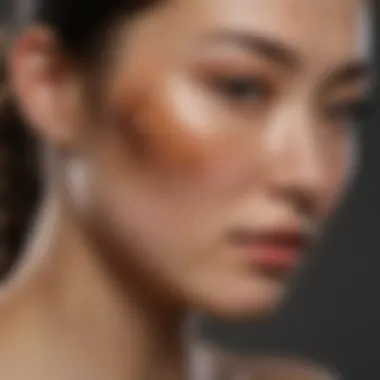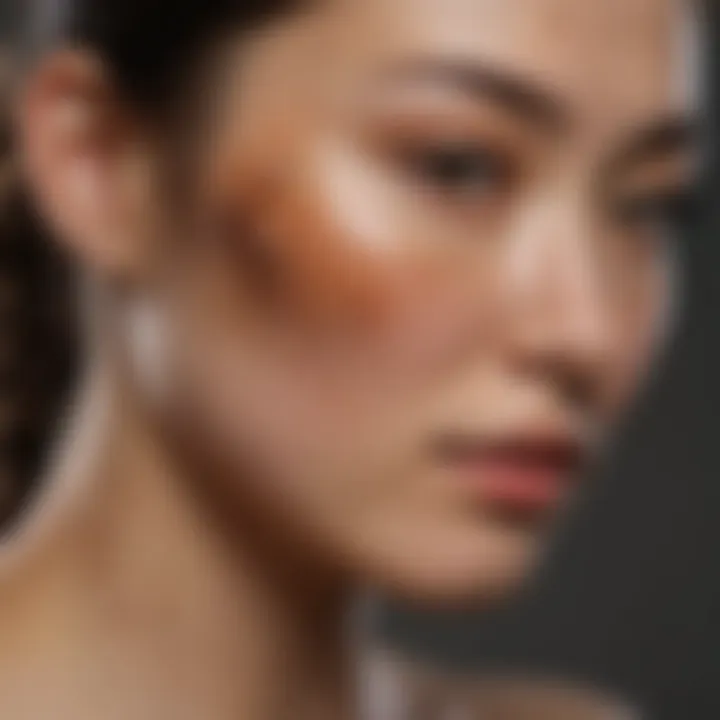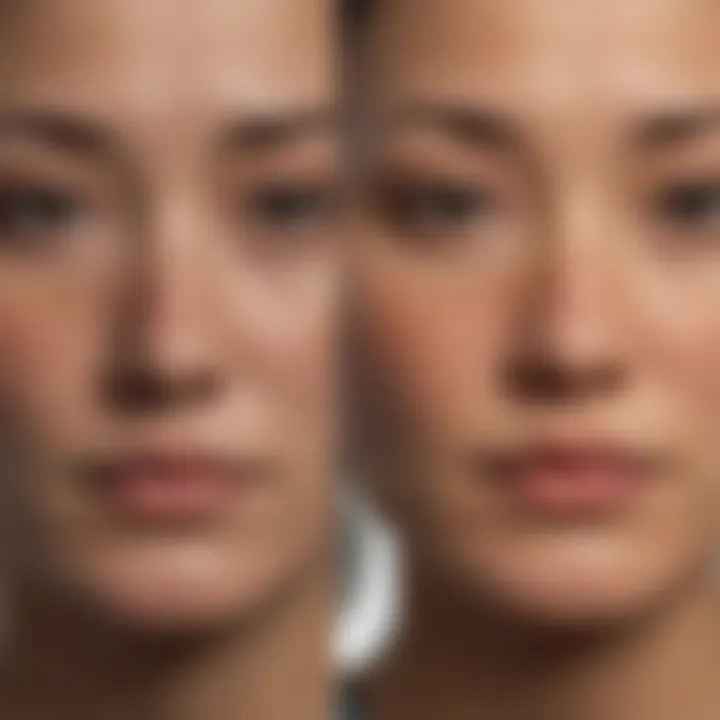Understanding Mongolian Spot Laser Removal


Intro
Mongolian spots are a common type of pigmented skin lesion, primarily found in individuals with darker skin tones. These spots can appear at birth or shortly after and often resemble bruises. While generally harmless and often fading over time, these marks can carry social stigma or raise misconceptions. Given this backdrop, the procedure for their removal, notably through laser treatment, has become an emerging area of interest for both medical professionals and the public.
In this exploration, we will delve into the characteristics of Mongolian spots, their social implications, and the recent advancements in laser removal options. This article seeks to illuminate the biological underpinnings of these lesions, assess the effectiveness of laser treatments, and discuss the safety concerns tied to this approach. We will draw on a variety of research studies and expert opinions, providing a nuanced understanding of the procedure.
Understanding these elements is crucial not only for practitioners in dermatology but also for those affected by Mongolian spots. As awareness of cosmetic procedures increases, so does the importance of discussing their implications thoroughly. Let us begin with examining the research context surrounding this topic.
Prelims to Mongolian Spots
Mongolian spots are often overlooked, yet they carry significant relevance in dermatology and cultural discussions. Understanding these pigmentations is crucial for medical professionals, as they are commonly mistaken for other skin conditions. This introduction sheds light on their defining characteristics, demographic prevalence, and cultural implications, setting the foundation for the subsequent sections of this article.
Definition and Characteristics
Mongolian spots are a type of congenital dermal melanocytosis. They typically appear as blue or bluish-gray markings on the skin, predominantly found in infants. These marks arise from melanocytes, which are skin cells responsible for pigment production, that remain trapped in the dermis during embryonic development. The spots commonly appear on the lower back and buttocks but can also manifest on other areas. They are painless and generally fade as the child grows, disappearing completely in many cases by the age of four.
The clarity in defining these characteristics is necessary for both parents and healthcare providers. Recognizing Mongolian spots can prevent unnecessary concerns regarding more serious dermatological issues.
Prevalence and Demographic Insights
Mongolian spots are most prevalent in individuals of certain ethnic backgrounds, with higher frequencies observed in East Asian, Southeast Asian, and Indigenous populations. Studies indicate that approximately 80 to 90 percent of newborns in these groups may present with one or more spots. Contrastingly, the prevalence is substantially lower in Caucasian and African populations, highlighting the genetic component of these markings.
Understanding the demographic patterns is essential for practitioners. It aids in correct identification and reduces the likelihood of misdiagnosis.
Cultural Perspectives
Culturally, Mongolian spots can hold various meanings depending on the societal context. In some communities, these spots are viewed as symbols of heritage and identity, while in others, they may prompt stigma or misconceptions. There are cases where parents face questions or challenges from others regarding the presence of these skin markings on their children. This indicates a wider need for education and public awareness to foster understanding and acceptance.
The Biology of Mongolian Spots
Understanding the biology behind Mongolian spots is crucial for grasping their nature and addressing concerns related to their appearance. These skin markings, primarily found in certain ethnic groups, have distinct biological underpinnings that merit examination. This section focuses on genetic factors and developmental aspects, providing insights into why these spots occur and how they relate to broader biological concepts.
Genetic Factors
Genetic predisposition plays a significant role in the presence of Mongolian spots. They are more prevalent among individuals with darker skin tones, particularly in populations from East Asia, Central Asia, and parts of Africa. Genetic variations in melanin production are key to these differences.
Research indicates that Mongolian spots form when melanocytes, the cells responsible for skin pigment, develop in the dermis rather than the epidermis during fetal development. This malplacement is believed to be influenced by heredity, with certain genetic traits making some individuals more likely to exhibit these spots than others.
Potential genetic markers for Mongolian spots have yet to be comprehensively established. However, understanding genes related to skin pigmentation can illuminate why these spots are common in certain families.
Also, a family history of Mongolian spots may increase the likelihood of occurrence in offspring. Thus, genetics not only explains the prevalence of these spots but also foregrounds the inherited nature of many skin conditions.
Developmental Aspects
The development of Mongolian spots is a topic of interest, particularly in terms of fetal growth. Studies suggest these spots begin to form towards the end of fetal life. As previously mentioned, the abnormal distribution of melanocytes results in the characteristic blue-gray color of Mongolian spots.
Factors such as gestational age can impact their appearance and resolution. Mongolian spots typically emerge in newborns and may affect approximately 80 to 90% of darker-skinned infants. As children grow, these spots often fade significantly or disappear entirely by the age of five.
Overall, understanding the developmental timeline of these spots aids clinicians in providing accurate information to parents. Advising parents on the commonality and transient nature of Mongolian spots can reduce worry and enhance awareness.
"Mongolian spots are a normal part of development in many infants, especially those with darker skin types. Knowledge about them can lead to improved comfort for parents experiencing this phenomenon in their children."
Social and Psychological Implications
The social and psychological implications of Mongolian spots and their laser removal are stark yet critical facets that warrant exploration. These implications can influence individuals' decisions about treatment and can impact their overall well-being. Understanding how society views Mongolian spots, along with addressing the stigma surrounding these skin marks, is vital in fostering greater public awareness and acceptance. This section unpacks the elements of stigmatization and how it affects individuals, as well as the substantial implications on self-esteem.
Stigmatization and Public Awareness


Despite being a common skin condition, Mongolian spots often carry social stigma. This stigma can stem from a lack of awareness or understanding of their benign nature. People frequently perceive these marks through the lens of stereotypes or preconceived notions, sometimes associating them with ethnic backgrounds or health conditions. Knowing this, it is essential to advocate for more significant public education to combat these stereotypes.
Raising awareness is not solely about dispelling myths; it is also about normalizing Mongolian spots. Parents and caregivers must feel comfortable discussing this condition openly. Furthermore, healthcare professionals play a pivotal role in informing patients about the harmless nature of these marks. Education can bridge the gap in understanding and alleviate some negative associations.
Public campaigns, alongside social media engagement, can significantly enhance awareness efforts. For instance, platforms like Facebook or Reddit can be utilized to share personal stories or informative content that discusses both Mongolian spots and the potential benefits of their removal. This type of information dissemination may aid in removing misconceptions and fostering acceptance.
"Education about Mongolian spots can help in breaking down the stigma and encourage parents to embrace their children's unique features."
Impact on Self-esteem
Self-esteem is profoundly affected when individuals feel judged or different due to their appearances. Mongolian spots can lead to feelings of self-consciousness. Children, once aware of social stigmas, may experience bullying, leading to negative feelings about their self-worth. For some, this may influence their social interactions and willingness to engage openly with peers.
Laser removal of Mongolian spots is often pursued not solely for aesthetic reasons but also to boost confidence and normalize appearance. Successfully removing these marks can enhance an individual's self-image. It is essential to consider that while laser treatments may mitigate concerns, they should not be seen as a requirement for self-acceptance.
Parents must balance the decision of removing Mongolian spots with fostering a supportive environment that encourages their children to appreciate their uniqueness. It is vital to engage in supportive conversations that nurture self-acceptance — online resources or community groups can provide a network where individuals can find shared experiences.
In summary, the social implications of Mongolian spots are interconnected with public awareness and personal perceptions. Understanding these dynamics will aid healthcare providers in addressing patients' concerns holistically, promoting healthier self-esteem while diminishing the societal stigma attached to these skin marks.
Laser Removal Procedure
The laser removal procedure represents a pivotal advancement in managing Mongolian spots, which are benign pigmented lesions commonly found in individuals of Asian and African descent. Understanding how this procedure works is essential for clinicians and patients alike.
The allure of laser removal lies in its non-invasive nature, providing a viable alternative to more invasive methods. This procedure utilizes concentrated light energy to target and fragment the pigment within the skin, leading to its gradual fading. Patient satisfaction is often high due to the efficacy and convenience of the treatment.
Thus, exploring the nuances of laser technology, the treatment process itself, and aftercare is crucial for anyone considering this option.
Overview of Laser Technology
Laser technology is at the heart of the removal process. Different types of lasers used in dermatology have various mechanisms and wavelengths.
- Q-switched lasers: These are most effective for pigmented lesions, including Mongolian spots. They work by emitting short bursts of energy that specifically target melanin without damaging surrounding tissue.
- Pulsed dye lasers: Known for their ability to treat vascular lesions, they may also be effective for certain cases of Mongolian spot removal, although less commonly utilized.
The choice of laser can significantly influence treatment outcomes, necessitating an informed discussion between the practitioner and the patient.
Treatment Process
The treatment process generally unfolds in several key stages. Initial consultation often involves a thorough assessment of skin type and condition. Once deemed suitable, the following steps are typical:
- Pre-treatment Preparation: The treatment area is cleansed. In some cases, a topical anesthetic might be applied to minimize discomfort.
- Laser Application: The laser device is set to the appropriate parameters based on the individual's needs. During the session, the practitioner will guide the laser over the affected area. Each pulse usually lasts only a fraction of a second.
- Post-Procedure Observations: After the session, the treated area is often monitored for immediate reactions, such as redness or swelling.
Most sessions vary in length, lasting from 20 minutes to an hour, depending on the extent of pigmentation needing address.
Post-Procedure Care
Post-procedure care is essential to ensure optimal healing and results. Practitioners typically provide detailed instructions, which may include:
- Avoiding Sun Exposure: Direct sunlight should be minimized post-treatment. Sunscreen with a high SPF is advised when outdoor exposure is unavoidable to prevent hyperpigmentation.
- Moisturizing the Area: Keeping the treatment site hydrated can help in the healing process. Gentle, fragrance-free moisturizers are recommended.
- Monitoring Complications: Patients should be aware of signs of complications like excessive redness, blistering, or infection. Prompt communication with the clinician is advised if these occur.
Adhering to these guidelines can significantly enhance the effectiveness of the laser removal process and promote skin health in the long term.
"Understanding the pre-and post-care requirements is as important as the procedure itself for achieving the best results."
In closing, the laser removal procedure is a promising avenue for individuals who wish to eliminate Mongolian spots. It combines advanced technology with careful procedural techniques and aftercare, reinforcing the overall safety and efficacy of the method.
Effectiveness of Laser Removal
The effectiveness of laser removal for Mongolian spots is a critical consideration for both patients and practitioners. It provides insight into the potential benefits of this treatment option, as well as any limitations or variables that may influence outcomes. Understanding how effective the procedure is can help guide individuals in their decision-making process, especially parents of children affected by these spots.


Clinical Studies and Results
Various clinical studies have been conducted to evaluate the effectiveness of laser treatments for Mongolian spots. These studies reveal important trends and results.
- Success Rates: Most studies suggest a high success rate for laser removal, with many patients experiencing significant lightening of the spots. Some reports indicate that about 80-90% of patients see desirable results after full treatment.
- Types of Lasers Used: The Q-switched Nd:YAG laser is commonly employed in these procedures due to its effectiveness in targeting melanin pigmentation. Research shows that this type of laser minimizes damage to surrounding skin, leading to more favorable outcomes.
- Follow-Up Analysis: Many studies emphasize the importance of follow-up assessments. Regular monitoring allows practitioners to make adjustments to the treatment plan, enhancing overall effectiveness and ensuring patient satisfaction.
In summary, the clinical evidence points to laser removal being a promising option for addressing Mongolian spots, provided the right techniques and follow-up care are adhered to.
Factors Influencing Outcomes
Several factors can significantly impact the outcomes of laser removal procedures. Understanding these variables can help set realistic expectations for patients.
- Skin Type: Variations in skin type and thickness can affect how the skin absorbs laser energy. Lighter skin generally yields better results compared to darker skin tones, where pigmentation differences may lead to less predictable outcomes.
- Spot Characteristics: The size, color, and depth of the Mongolian spot also play crucial roles. Larger or darker spots may require more sessions and could respond differently compared to smaller or lighter spots.
- Patient’s Age: Age can also be a determining factor. Young children often heal faster and may respond better to treatment than older individuals, who might experience more prolonged recovery.
- Post-Treatment Care: Adhering to proper aftercare recommendations is essential for achieving the best results. Patients are typically advised to protect the treated area from sun exposure, apply prescribed topical treatments, and avoid irritating substances.
"Individual results of laser treatments can vary widely based on multiple influencing factors, making it vital to tailor the approach to each specific case."
Safety and Risks
Understanding the safety and risks associated with Mongolian spot laser removal is essential for informed decision-making. Educating patients about potential side effects and long-term effects helps address concerns about the procedure. It is important to analyze both the benefits and the considerations involved in this treatment.
Common Side Effects
When individuals undergo laser removal for Mongolian spots, they may experience several common side effects. These side effects can vary based on skin type, the specific laser technology used, and factors such as the practitioner’s expertise. Here are some usual side effects:
- Redness and Swelling: After the procedure, mild redness and swelling at the treatment site is common. This typically subsides within a few hours to days.
- Discomfort: Some patients report a sensation similar to that of a sunburn during and after treatment. This discomfort is usually manageable with over-the-counter pain relief.
- Blistering: In rare cases, blisters can form as part of the healing process. Proper care can mitigate this.
- Hyperpigmentation: While laser treatment often aims to reduce pigmentation, paradoxical hyperpigmentation can occur, particularly in darker skin types.
"Awareness of side effects contributes to realistic expectations, which is vital for patient satisfaction."
These side effects emphasize the need for choosing a qualified provider and having a thorough consultation before undergoing the procedure. It allows for proper assessment and management of expectations.
Long-term Considerations
Long-term safety is an important aspect of Mongolian spot laser removal. Many people focus on immediate results, but the endurance of effects and potential complications should also be examined.
- Skin Sensitivity: Post-treatment, skin may remain sensitive for a while. Continuous exposure to sunlight without protection can lead to adverse outcomes.
- Scarring: Although many procedures are effective, there is still a risk of scarring, especially if aftercare procedures are not followed.
- Psychological Impact: Understanding the lasting effects of treatment on self-image and mental health is vital. Positive results can increase confidence, but unsatisfactory results might lead to emotional distress.
- Regular Follow-Ups: Maintaining a schedule for follow-up visits allows clinicians to monitor recovery and identify any long-term problems early on.
In summary, while laser treatment for Mongolian spots is generally safe, the potential for side effects and long-term implications requires careful consideration. Being informed helps individuals to navigate the complexities of the procedure and make educated decisions regarding their skin health.
Alternatives to Laser Removal
The discussion surrounding alternatives to laser removal for Mongolian spots is essential for those seeking options beyond conventional treatment. Understanding these alternatives can provide individuals with varied degrees of effectiveness and risk. While laser therapies have gained popularity, some patients may prefer less invasive methods. This section will outline natural remedies and cosmetic solutions, evaluating their benefits and potential drawbacks.
Natural Remedies
Natural remedies often attract individuals who prefer to avoid medical procedures. Some proponents believe that certain natural substances can fade Mongolian spots, although clinical evidence may be limited. Common remedies include:
- Aloe Vera: Known for its soothing properties, aloe vera is sometimes applied to the skin in hopes of reducing pigmentation. Regular application may lead to some lightening effects.
- Vitamin C: This antioxidant is regarded for its skin-brightening properties. Topical formulations containing vitamin C may assist with reducing discoloration over time.
- Licorice Extract: Some research suggests that licorice extract can inhibit melanin production, potentially aiding in the lightening of skin spots.
While these remedies are appealing, it is crucial to approach them with realistic expectations. The efficacy of such treatments varies widely among individuals. Moreover, consistency in application is required, as results may take time to appear. It is wise to consult with a dermatologist before trying these options to ensure safety and suitability.
Cosmetic Solutions
Cosmetic solutions offer another avenue for individuals looking to manage the appearance of Mongolian spots. Unlike laser treatments, which focus on removal, cosmetic solutions focus on concealing. This option is often employed when immediate results are desired. Popular choices include:
- Cover-up Makeup: Specially formulated concealers can effectively mask the appearance of Mongolian spots. Products from brands like Fenty Beauty and Dermablend may provide desired coverage without irritating sensitive skin.
- Tinted Moisturizers: Many individuals opt for tinted moisturizers that blend seamlessly with their skin tone. These products offer hydration while providing light coverage.
- Color Correctors: For individuals who prefer more targeted coverage, color-correcting creams can neutralize pigmentation before applying foundation.
Cosmetic solutions can offer temporary relief from the visibility of Mongolian spots. They require no medical intervention and provide immediate gratification. However, they do not address the underlying pigmentation issue; thus, individuals seeking a permanent solution might need to consider other options.


"Cosmetic solutions are often chosen for their immediacy, providing a way to conceal rather than remove."
Patient Considerations
The topic of Patient Considerations is critical in discussions surrounding Klingon spots and their removal. For individuals contemplating laser removal, understanding these considerations can greatly impact their decision-making process. It encompasses and influences various aspects such as informed consent, cost, and accessibility. Each element plays a significant role in guiding patients towards a satisfactory outcome while ensuring their rights and needs are respected.
Informed Consent
Informed consent stands as a pivotal component in any medical procedure, including laser removal of Mongolian spots. It is crucial for patients to fully understand the potential risks, benefits, and complications associated with the treatment. The process should involve thorough dialogue between the healthcare provider and the patient.
Patients must be made aware of:
- Expected Outcomes: Patients should have realistic expectations regarding the results. Not all Mongolian spots may respond uniformly to laser treatment.
- Risks and Side Effects: Detailed explanations of possible side effects, such as temporary discoloration or skin irritation, should be provided. This helps patients gauge their own tolerance levels.
- Alternative Options: It is also essential to discuss available alternatives to laser removal, allowing patients to make informed choices that align with their preferences.
Providing clear and comprehensive information ensures that the patient is empowered to make decisions about their health care. This fosters a trusting relationship between the patient and the medical provider.
Cost and Accessibility
Cost and accessibility are paramount when considering laser removal of Mongolian spots. The financial aspect can vary widely depending on geographical area, provider experience, and specific technology used in the procedure. Factors affecting costs include:
- Consultation Fees: Initial assessments may incur fees that vary by clinic.
- Per Session Pricing: Multiple sessions may be necessary, each with a set fee. This can add significant overall expense.
- Insurance Coverage: Not all insurance plans cover cosmetic procedures. Understanding one's coverage and potential out-of-pocket costs is essential before proceeding.
Accessibility can present another layer of complexity. Considering the location of specialized clinics is vital for patients. They should evaluate:
- Local Availability: Not all regions offer access to skilled professionals for this treatment.
- Travel Expenses: Patients may need to travel, increasing overall costs.
In summary, both informed consent and cost and accessibility should be thoroughly examined by anyone considering Mongolian spot laser removal. The thoughtful evaluation of these factors not only benefits patient experience but also enhances care outcomes.
"Informed consent is not just a formality but an essential component of ethical medical practice."
By understanding these considerations, patients place themselves in a stronger position to navigate their treatment journey effectively.
Expert Opinions
Expert opinions play a crucial role in shaping the understanding and approach towards Mongolian spot laser removal. Insights from both dermatological and psychological professionals provide a well-rounded perspective on the effectiveness, safety, and implications of the procedures involved. Engaging with experts highlights not only the medical viability of treatments but also the nuanced emotional responses of patients undergoing this process. The integration of these opinions fosters a comprehensive examination of laser removal options, ensuring that diverse aspects are considered.
Dermatological Perspectives
Dermatologists offer specialized insights based on years of training and clinical experience. They can evaluate the physiological aspects of Mongolian spots and the appropriateness of laser treatments. Importantly, they share their knowledge of different laser technologies that can be used for removal.
- Clinical Evidence: Dermatologists often reference clinical studies that document the effectiveness of particular lasers in treating Mongolian spots. For instance, studies have shown that Q-switched lasers are effective in significantly reducing the appearance of these spots.
- Skin Type Considerations: Dermatologists stress the importance of considering a patient’s skin type before recommending a laser treatment. Individuals with darker skin tones may have a higher risk for complications like post-inflammatory hyperpigmentation.
- Treatment Protocols: Experts typically outline standard treatment protocols which may include multiple sessions to achieve desired outcomes. They take into account individual variations in healing and pigmentation.
Ultimately, dermatological perspectives underscore the need for personalized treatment plans, balancing effectiveness with safety.
Psychological Insights
The psychological ramifications of having Mongolian spots and undergoing laser removal are profound. Mental health professionals highlight how physical appearance impacts self-esteem and social interactions. Their insights are significant when considering the patient experience related to Mongolian spots.
- Self-Perception: Many individuals may feel self-conscious about their Mongolian spots, and removal can be tied to improved self-image. Counseling can assist patients in preparing for the emotional aspects of the process.
- Expectations Management: Psychologists often stress the importance of setting realistic expectations. Understanding that results can vary is crucial for emotional preparedness.
- Impact of Stigma: The societal stigma around skin markings can affect mental health. Insights from psychological professionals can inform strategies to cope with negative perceptions and promote a supportive environment for patients.
Closure
The conclusion of this article encapsulates the significance of Mongolian spot laser removal. It emphasizes the evolving landscape of treatment options, particularly in light of the social stigmas attached to Mongolian spots. Many individuals seek removal for various reasons—cosmetic preferences, psychological health, or societal acceptance. Laser removal stands out as a specialized procedure that not only targets the pigmentation but also addresses the broader implications tied to identity and self-perception.
Summative Insights
In summarizing the discussions throughout the article, laser removal of Mongolian spots presents itself as a viable option for those looking to mitigate the visibility of these marks. Effectiveness varies based on individual skin type and the techniques applied. Clinical studies indicate a high success rate in pigment reduction with minimal side effects. However, each case is unique, and thorough consultations with dermatologists are crucial. Patients must be informed not only about the potential physical outcomes but also about the emotional aspects that relate to their self-image. Education plays a pivotal role here, making it important for both practitioners and patients to understand the science behind Mongolian spots and the nuances involved in their treatment.
Future Directions of Research
Research on Mongolian spots and their treatment is still in its early stages but shows promise. Future inquiries should focus on:
- Long-term effects of laser treatment on patients with various skin types.
- Comparative studies that evaluate different laser technologies—such as the use of Q-switched ND:YAG lasers versus more advanced techniques.
- Psychological impact assessments following treatment, which would provide deeper insight into how pigment alteration affects self-esteem and social dynamics.
- Emerging technologies in dermatology that might offer less invasive techniques with improved outcomes.















